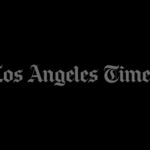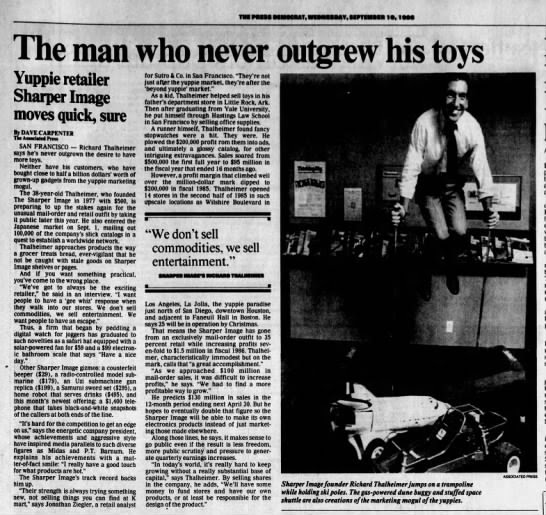Richard Thalheimer says he’s never outgrown the desire to have more toys.
Neither have his customers, who have bought close to half a billion dollars’ worth of grown-up gadgets from the yuppie marketing mogul.
The 38-year-old Thalhelmer, who founded The Sharper Image in 1977 with $500, is preparing to up the stakes again for the unusual mail-order and retail outfit by taking It public later this year. He also entered the Japanese market on Sept. 1, mailing out 100,000 of the company’s slick catalogs in a quest to establish a worldwide network.
Thalheimer approaches products the way a grocer treats bread, ever-vigilant that he not be caught with stale goods on Sharper Image shelves or pages.
And if you want something practical, you’ve come to the wrong place.
“We’ve got to always be the exciting retailer,” he said in an interview. “I want people to have a ‘gee-whiz’ response when they walk into our stores. We don’t sell commodities, we sell entertainment. We want people to have an escape.”
Thus, a firm that began by peddling a digital watch for joggers has graduated to such novelties as a safari hat equipped with a solar-powered fan for $59 and a $99 electronic bathroom scale that says “Have a nice day.”
Other Sharper Image gizmos: a counterfeit beeper ($29), a radio-controlled model submarine ($179), an Uzi submachine gun replica ($199), a Samurai sword set ($295), a home robot that serves drinks ($495), and this month’s newest offering: a $1,400 telephone that takes black-and-white snapshots of the callers at both ends of the line.
“It’s hard for the competition to get an edge on us,” says the energetic company president, whose achievements and aggressive style have inspired media parallels to such diverse figures as Midas and P.T. Barnum. He explains his achievements with a matter-of-fact smile: “I really have a good feel for what products are hot.”
The Sharper Image’s track record backs him up.
“Their strength is always trying something new, not selling things you can find at K-mart,” says Jonathan Ziegler, a retail analyst for Sutro & Co. in San Francisco. “They’re not just after the yuppie market, they’re after the ‘beyond yuppie’ market.”
As a kid, Thalhelmer helped sell toys in his father’s department store in Little Rock. Ark. Then after graduating from Yale University, he put himself through Hastings Law School in San Francisco by selling office supplies.
A runner himself, Thalhelmer found fancy stopwatches were a hit. They were. He plowed the $200,000 profit from them into ads, and ultimately a glossy catalog, for other intriguing extravagances. Sales soared from $500,000 the first full year to $95 million in the fiscal year that ended 16 months ago.
However, a profit margin that climbed well over the million-dollar mark dipped to $200,000 in fiscal 1985. Thalheimer opened 14 stores in the second half of 1985 in such upscale locations as Wilshire Boulevard in Los Angeles, La Jolla, the yuppie paradise just north of San Diego, downtown Houston, and adjacent to Faneuil Hall in Boston. He says 25 will be in operation by Christmas.
That means the Sharper Image has gone from an exclusively mail-order outfit to 35 percent retail while increasing profits seven-fold to $1.5 million in fiscal 1986. Thalheimer, characteristically immodest but on the mark, calls that “a great accomplishment.”
“As we approached $100 million in mail-order sales, it was difficult to increase profits,” he says. “We had to find a more profitable way to grow.”
He predicts $130 million in sales in the 12-month period ending next April 30. But he hopes to eventually double that figure so the Sharper Image will be able to make its own electronics products instead of just marketing those made elsewhere.
Along those lines, he says, it makes sense to go public even if the result is less freedom, more public scrutiny and pressure to generate quarterly earnings increases.
“In today’s world, it’s really hard to keep growing without a really substantial base of capital,” says Thalheimer. By selling shares in the company, he adds, “We’ll have some money to fund stores and have our own products, or at least be responsible for the design of the product”.




